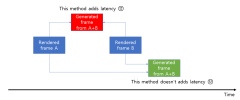DavidGraham
Veteran
This, DLSS3 is just an added mode on top of DLSS2, it benefits from the reduction of latency gained by DLSS2, and also benefits from latency reduction from Refelx.Add the DLSS super resolution into the equation, and all combined will have way lower latency in comparison with native rendering.
So, it will probably look like this:
1080p native latency: 9ms
2160p native latency: 20ms
1080p to 2160p DLSS2 upscale latency: 10ms
1080p to 2160p DLSS3 frame generation latency: 12ms
1080p to 2160p DLSS3 + Reflex latency: 11ms

